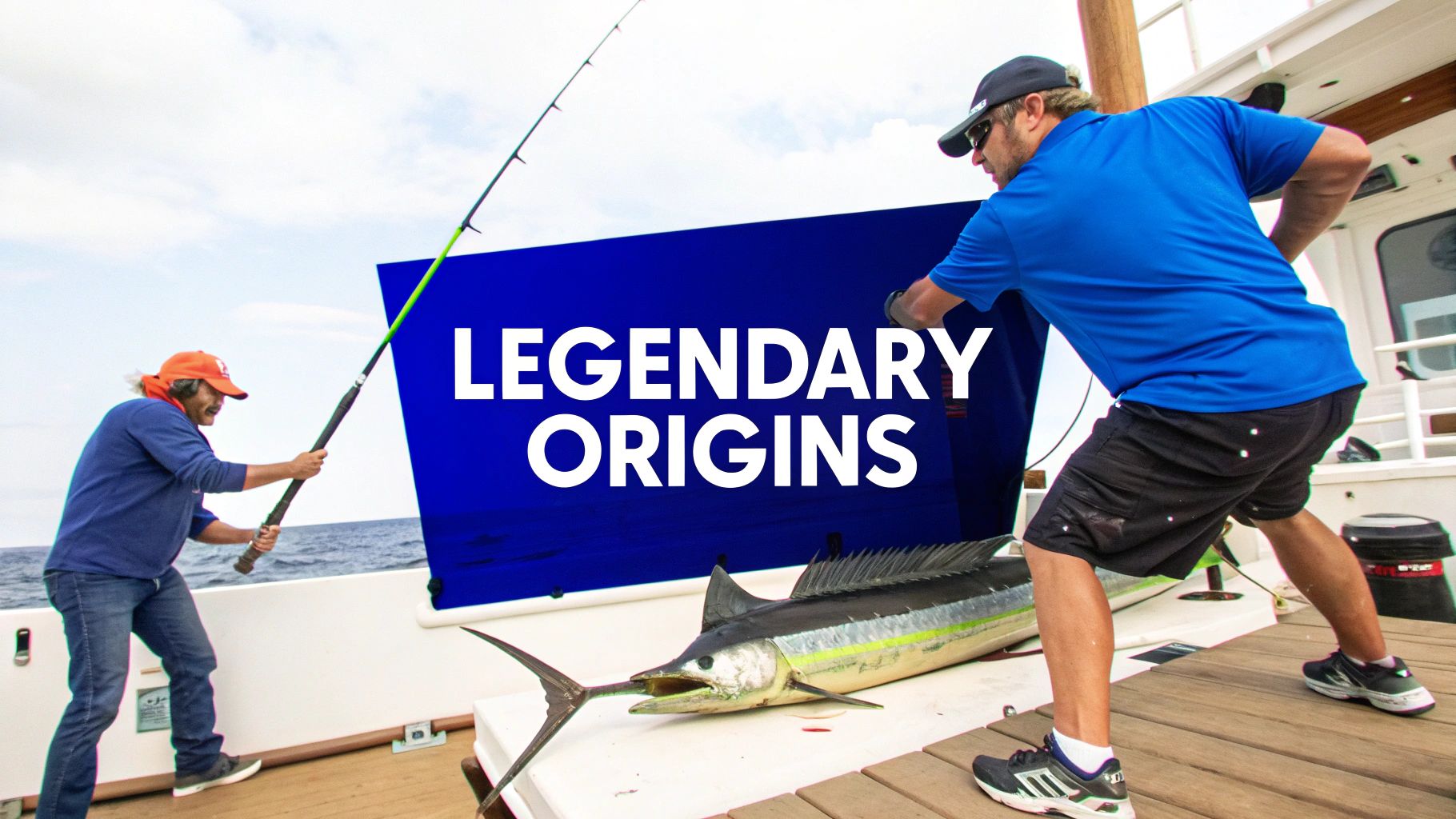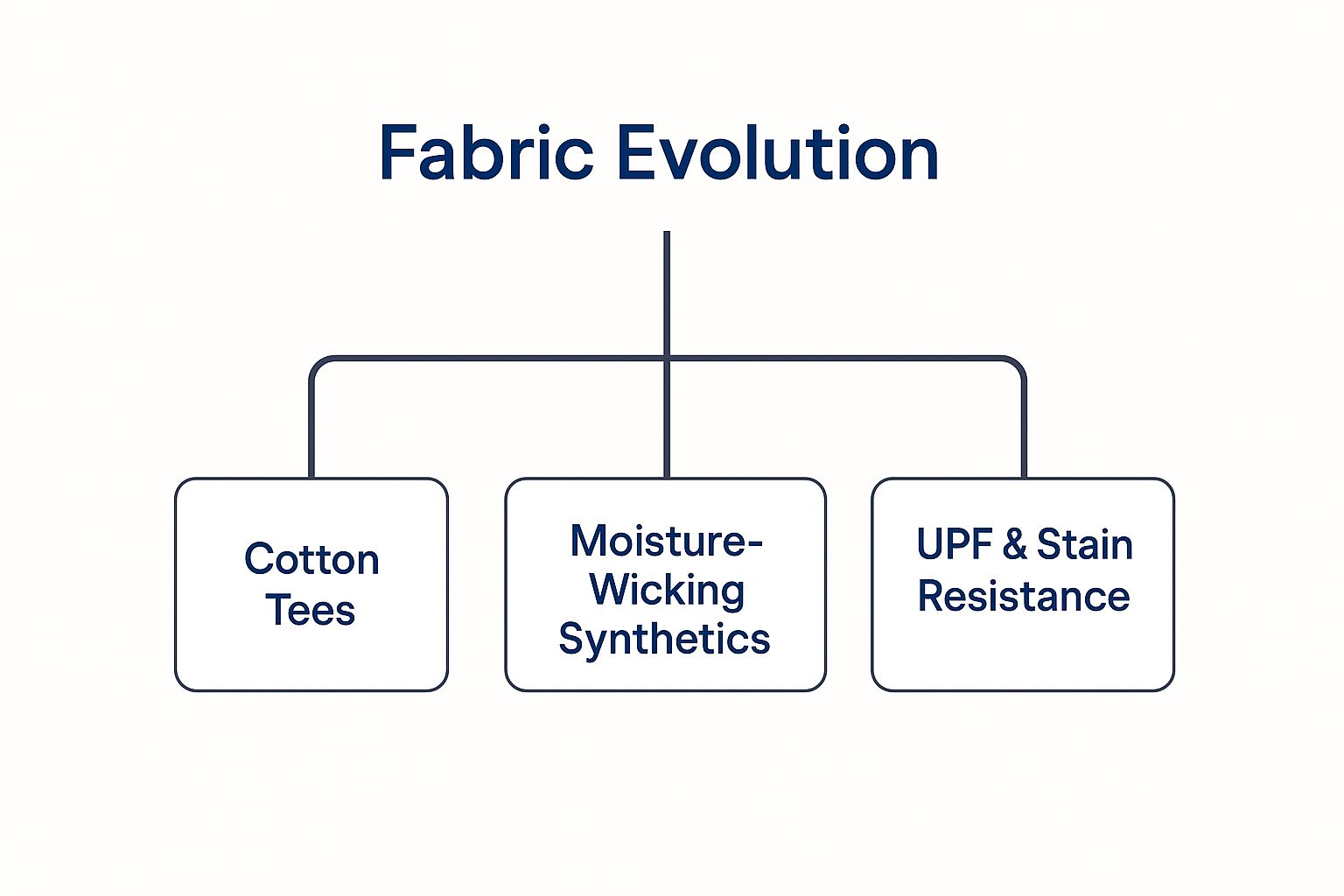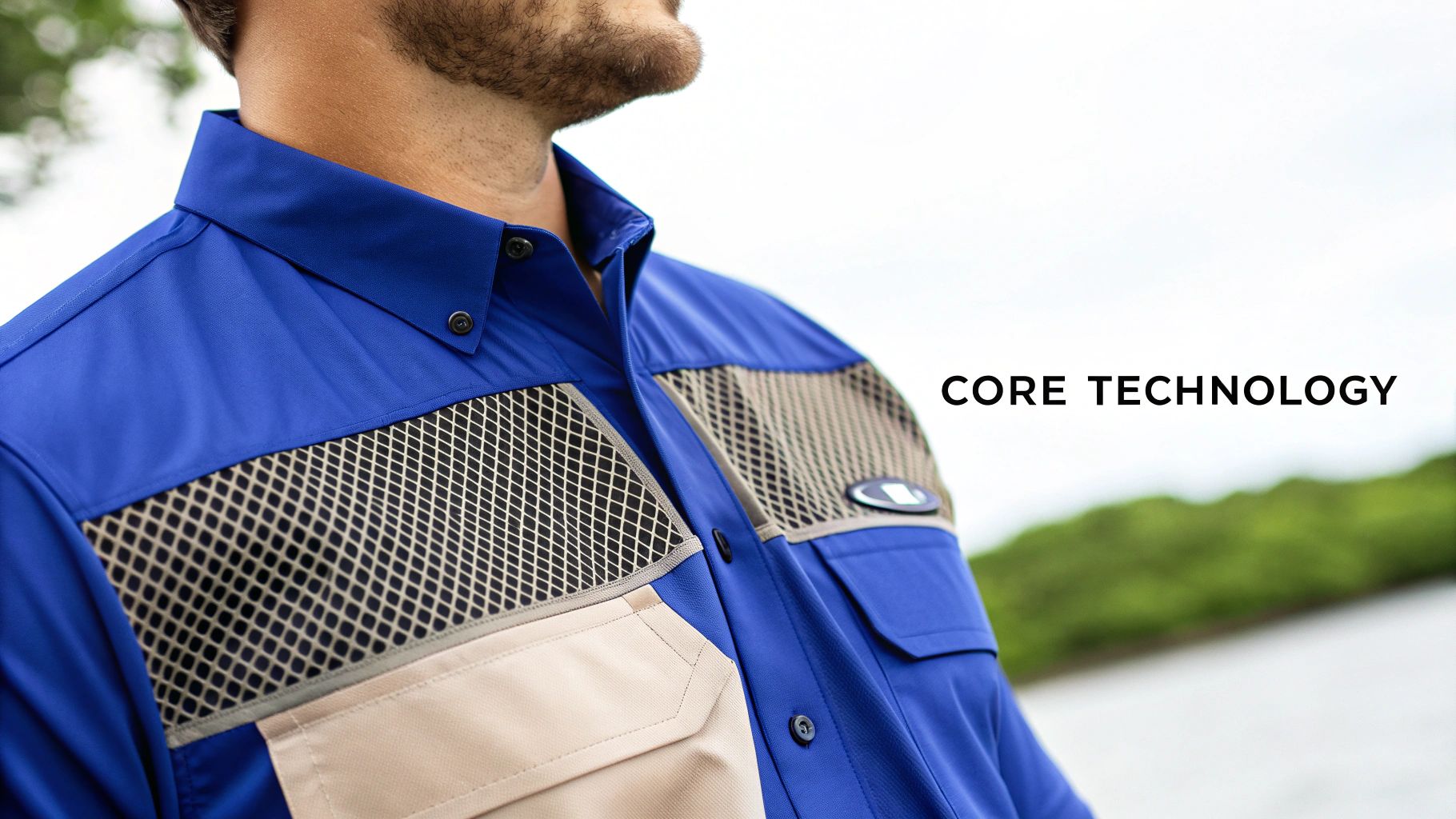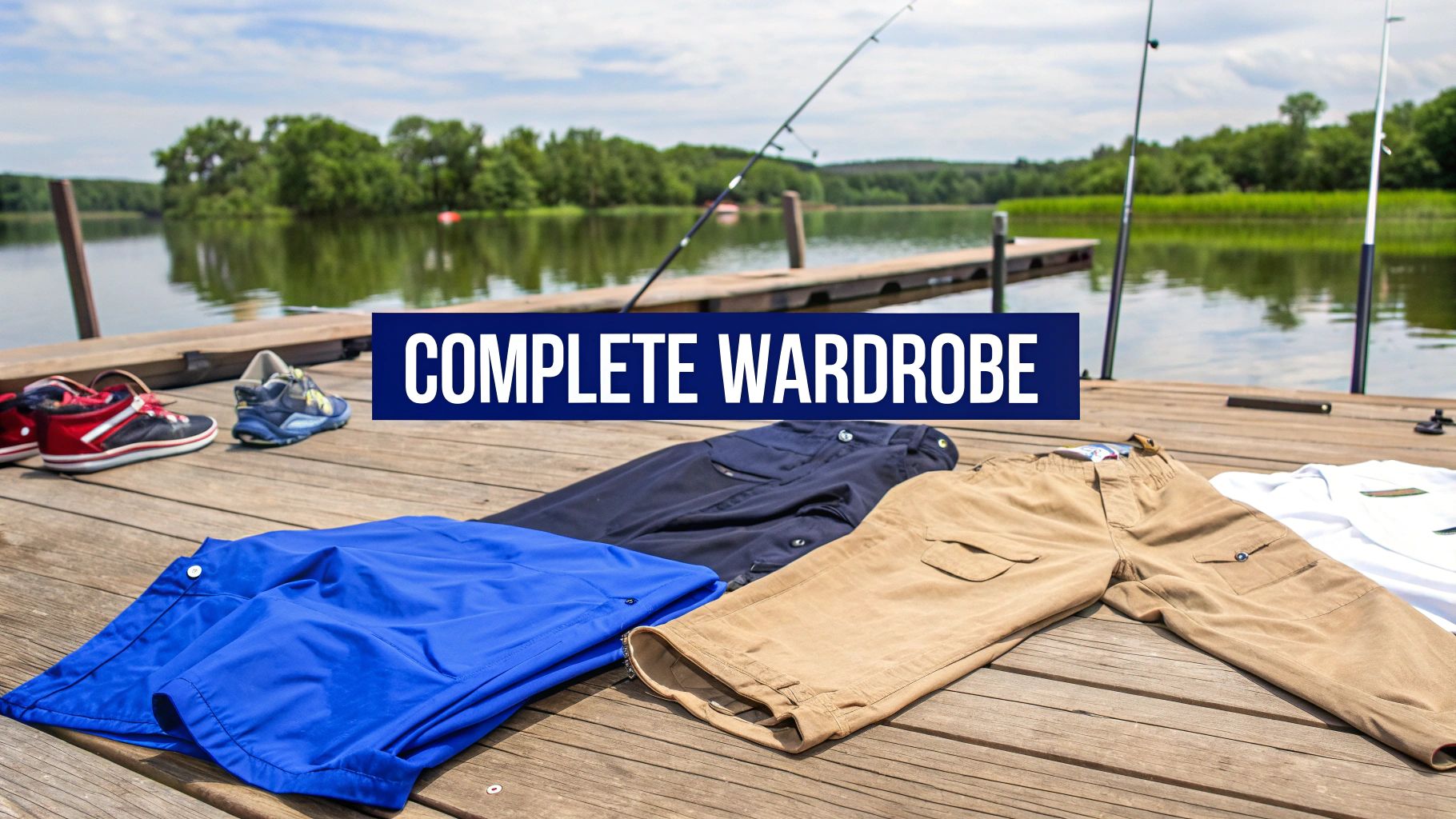Pro Insights on Performance Fishing Gear Clothing
Performance fishing gear is so much more than just a shirt or a pair of shorts. It’s a purpose-built tool, specifically engineered to give anglers an advantage when they're facing down the elements. This gear was born from the incredibly demanding world of saltwater sportfishing tournaments, and it delivers critical sun protection, moisture control, and a freedom of movement that the old-school stuff just couldn't touch.
How Legends Forged Modern Fishing Apparel

Before today's technical fabrics ever existed, saltwater sportfishing was an absolute beatdown. Think about sportfishing legends like Ed and Frank Murray, true titans of the tournament scene. For decades, these guys were out there battling monster fish for hours under a brutal, relentless sun, wearing nothing more than heavy cotton t-shirts and leaky rain slickers. Their story is directly woven into the fabric of modern angler apparel.
These early pioneers knew that winning a high-stakes saltwater sportfishing tournament wasn't just a fight against the fish—it was a war against the environment itself. More often than not, their gear was actually working against them, putting them at a serious disadvantage when money and reputation were on the line.
The Failures of Old-School Gear
Can you imagine being locked in a grueling, hours-long fight with a powerful fish while your clothes are actively making it harder? The Murrays didn't have to imagine it; they lived it in countless tournaments. Their time on the water exposed every single flaw in the gear of the day:
- Sun Exhaustion: A cotton t-shirt offered almost zero real protection from UV rays. This led to nasty sunburns and heat exhaustion that could cut a tournament day short in a hurry.
- Waterlogged Weight: Once cotton or old rain gear got wet from spray or sweat, it became incredibly heavy, restricting movement and draining an angler's stamina during a critical fight.
- Painful Chafing: Damp, rough fabric rubbing against your skin for hours on end creates some serious irritation and chafing, turning an epic fight into a miserable ordeal.
The real challenge on the water isn't just the fish; it's managing your own energy and focus. The wrong clothing can drain both faster than any fight, turning a potential victory into a story of 'the one that got away.'
A Demand for Better Solutions
The Murray Brothers and other anglers of their era knew that to compete at the highest level, they needed gear that performed as hard as they did. They couldn't afford to be weighed down, overheated, or dangerously exposed to the sun. Their frustrations and makeshift solutions—from literally cutting vents in their shirts to hunting for any lightweight material they could find—created an undeniable demand in the market.
This was never just about comfort. It was about performance, safety, and finding that crucial competitive edge in elite saltwater sportfishing tournaments. To get a feel for this rich heritage, you can learn more about the history of sportfishing and the icons who shaped it.
This relentless push from legendary anglers laid the foundation for the performance fishing gear clothing we have today. Their experiences on the water directly fueled the innovations we now take for granted, proving that every stitch and every feature has a purpose—one born from decades of trial and error on the open ocean.
From Cotton Tees to Advanced Technical Fabrics
Picture yourself in the fighting chair, locked in an hours-long battle with a marlin under a relentless sun. For sportfishing pioneers like Ed and Frank Murray, this wasn't just a tough day—it was every day on the water in the heat of competition. Their go-to gear? A simple cotton t-shirt, which went from a basic piece of clothing to a genuine liability the second the sweat and sea spray hit.
Cotton is basically a sponge. As soon as it gets wet, it stays wet. That means it gets heavy, abrasive, and makes it nearly impossible for your body to cool down. It offered next to no sun protection and would cling and restrict movement when you needed it most. This wasn't just about being uncomfortable; it was a serious disadvantage in the high-stakes world of saltwater fishing.
The Rise of Performance Synthetics
Everything changed with the invention of modern synthetic fabrics. These materials were engineered from the ground up to do the exact opposite of what cotton does. Instead of trapping moisture, they were designed to pull sweat away from the skin and spread it across the fabric’s surface so it could evaporate in a flash.
This shift was a total game-changer for anglers. Suddenly, a moisture-wicking shirt meant staying drier, feeling lighter, and being far more comfortable during a long day on the boat. It helped put an end to the painful chafing the Murrays knew all too well and gave anglers much better control over their body temperature—a critical factor for keeping up your stamina during a grueling fight. If you're looking for the best modern options, our guide on the best fishing shirts for hot weather dives deep into these solutions.
This infographic lays out the evolution, showing how we got from basic fabrics to today's high-tech gear.

As you can see, it was a clear progression from materials that just covered you to fabrics that actively helped you.
Adding Layers of Protection
Once the basics of moisture management were solved, fabric technology kept pushing forward. The next major leap for performance fishing gear clothing was weaving Ultraviolet Protection Factor (UPF) ratings right into the fabric itself.
Think of a UPF 50+ shirt as wearable, all-day sunscreen. It creates a physical shield that blocks over 98% of harmful UVA and UVB rays. That's a level of protection old-school cotton could never even dream of.
From there, the innovations kept coming. Stain-resistant treatments were added to repel fish blood and grime, which kept gear looking fresh trip after trip. These functional upgrades are a big reason why the fishing apparel market, valued at around $5.2 billion in 2023, is expected to climb to $8.9 billion by 2033. This evolution from a simple tee to a technical tool perfectly captures the story of modern angling apparel.
Anatomy of a High-Performance Fishing Shirt

So, what really separates a top-shelf fishing shirt from a regular old athletic top? It’s not just about a fancy logo. It’s a whole system of technologies built to solve the very real problems anglers face out on the water, especially during those grueling saltwater tournaments.
Every single feature you see in modern performance fishing gear clothing is there for a reason. It’s a direct answer to the sun, the salt, and the sweat—transforming a simple shirt into a piece of essential equipment.
At the heart of it all is sun management. When you're on the water for eight, ten, or even twelve hours, the sun isn't just uncomfortable; it’s a serious health concern. This is where the Ultraviolet Protection Factor (UPF) rating becomes absolutely critical.
The All-Day Sun Shield
A shirt with a UPF 50+ rating is like having a reliable, all-day shield built right in. Forget constantly reapplying sunscreen. The protection is woven directly into the fabric itself, blocking over 98% of harmful UVA and UVB rays.
For guys like the Murrays spending hours fighting a big fish, there’s no time to stop and slather on more lotion. Their gear has to provide constant, unwavering protection from that relentless sun. This one feature has completely changed the game for angler safety and endurance.
Your Personal Cooling System
Beyond the sun, a great fishing shirt needs to act like a personal cooling system. When the action heats up, you’re going to sweat. An ordinary cotton shirt just soaks it up, getting heavy and clammy. A true performance shirt, on the other hand, is built with advanced moisture-wicking fabric.
Think of moisture-wicking technology like a one-way street for sweat. It actively pulls moisture away from your skin and pushes it to the outer surface of the fabric. Once there, it evaporates in a flash, keeping you cool and dry.
This quick-drying process is a lifesaver. It prevents the chafing and general misery that can cut a long day on the water short, letting you stay focused on the fish, not on your sticky shirt.
Built for Constant Airflow
Even the best wicking fabric needs a little help from good old-fashioned airflow. That’s why the best fishing shirts have strategic ventilation built right into their design to keep you from overheating. This is more than just using a thin material; it's about smart engineering.
- Hidden Mesh Panels: You'll often find these tucked away under the arms or across the shoulder blades. They act like little exhaust vents, letting hot air out and cool breezes in.
- Vented Backs: The classic cape-style back with a mesh lining is a hallmark of a great fishing shirt. It creates a channel for air to move freely as you cast and work the deck.
Modern shirts are engineered to be a complete system. To show how these technologies work together, let's break down the most important features you'll find.
Essential Performance Fishing Shirt Features
| Feature | Primary Function | Benefit on the Water |
|---|---|---|
| UPF 50+ Protection | Blocks UVA/UVB Rays | Provides all-day sun protection without needing to reapply sunscreen. |
| Moisture-Wicking | Pulls Sweat from Skin | Keeps you dry, cool, and prevents chafing during intense activity. |
| Strategic Ventilation | Promotes Air Circulation | Vents and mesh panels allow heat to escape, preventing overheating. |
| Antimicrobial Treatment | Inhibits Odor Bacteria | Keeps your shirt smelling fresh, even after long, hot days or multi-day trips. |
| Stain Resistance | Repels Liquids & Grime | Makes it easy to wash out fish slime, blood, and salt spray. |
| Lightweight Fabric | Reduces Bulk & Weight | Ensures you can move freely and cast without restriction all day long. |
As you can see, each feature serves a distinct purpose, but they all work together to keep you comfortable and protected.
Finally, after a long day at sea, the last thing you want is gear that stinks. That’s why many modern shirts are treated with antimicrobial properties. This clever addition stops odor-causing bacteria from growing in the first place, meaning your shirt stays fresher for way longer. It’s a small detail that makes a huge difference on a multi-day fishing trip.
Each one of these elements plays a part, creating a piece of gear that doesn't just look the part—it actively helps you perform better on the water.
Building Your Full Angler Wardrobe

A great performance shirt is the heart of your fishing kit, but it's really just the starting point. If you want to be truly ready for anything the elements throw at you, you need to think about your gear as a complete head-to-toe system. The same ideas that make a shirt great—sun protection, moisture-wicking, and freedom of movement—apply to every other piece of performance fishing gear clothing, especially your bottoms and outerwear.
Just ask sportfishing legends like the Murray Brothers. For them, what they wore on their lower half was every bit as critical as their shirt. Between the constant sea spray, sweat, and general grime of a day on the water, old-school canvas or denim shorts were a disaster waiting to happen. They'd get soaked, become incredibly heavy, and cause painful chafing that could ruin a tournament day.
The Foundation: Performance Shorts and Pants
Modern fishing shorts and pants are engineered to solve those exact problems, starting with advanced, quick-drying fabrics. This isn't just a nice-to-have; it's a non-negotiable for anyone who's serious about their time on the water. When a wave splashes over the gunwale, you need shorts that shed that water and are dry again in minutes, not something that stays soggy and weighs you down for hours.
But it’s not just about staying dry. Today's gear is built for the athletic side of fishing. When you’re shopping, keep an eye out for these game-changing features:
- Stain Resistance: Look for gear with special treatments that repel fish blood, oil, and whatever else you get into, keeping you looking sharp trip after trip.
- Articulated Knees: This is a fancy way of saying the fabric is pre-bent to match your natural movement, so your pants work with you—not against you—when you bend down or kneel.
- Gusseted Crotch: A diamond-shaped panel of fabric sewn into the inseam makes a world of difference, giving you a far greater range of motion for casting, climbing around the boat, or wiring a big fish.
These aren't just comfort features; they're about endurance. When you can move freely without your clothes fighting you, you save energy and stay focused on landing the fish. It’s a lesson the Murrays learned the hard way over countless saltwater sportfishing tournaments.
Your Shield Against the Storm
The final piece of the puzzle is your outerwear—that critical barrier between you and a sudden squall. As any offshore angler can tell you, the weather can turn on a dime. The real trick with outerwear is finding that perfect balance: it needs to be completely waterproof, but it also has to let your body breathe.
If a jacket keeps the rain out but traps all your sweat in, you'll end up just as soaked from the inside. It creates a miserable "personal greenhouse" effect that can get uncomfortable, fast. That's why the best performance fishing gear clothing uses advanced membranes that are smart enough to block water droplets from getting in while still letting water vapor (your sweat) escape. It’s the kind of tech the Murray Brothers could have only dreamed of back in their early tournament days.
This constant push for better materials is a big reason the market keeps growing. The global fishing apparel market was valued at around $54 million and is on track to hit $62.8 million by 2031. It’s clear proof that more and more anglers are investing in specialized gear. You can learn more about these market trends to see how demand for better, more technical clothing is shaping the whole industry.
How to Select Gear Like a Tournament Pro
After decades spent in the high-stakes world of saltwater sportfishing tournaments, legends like Ed and Frank Murray learned a critical lesson: your gear is a strategic advantage. Choosing the right performance fishing gear clothing isn't just about looking the part. It's about building a complete system that lets you outlast the fish and the elements, turning your wardrobe into a toolkit for success.
The entire foundation of this pro-level strategy boils down to layering. The Murray Brothers didn't have the luxury of today's high-tech fabrics, but they knew the principle inside and out. Weather offshore is notoriously fickle—a calm, sunny morning can become a windy, spray-soaked afternoon in the blink of an eye. A pro never dresses for the conditions they see at the dock; they dress for what the day could throw at them.
This means your system should start with a lightweight, moisture-wicking base layer that pulls sweat away from your skin, keeping you dry even on the hottest days. From there, you can add or shed layers as needed—maybe a light fleece or a fully waterproof shell—to adapt on the fly without ever getting too hot, too cold, or too damp.
Non-Negotiable Features for Serious Anglers
When you're picking out your gear, you have to think like a tournament pro who can't afford a single weak link. Certain features are absolutely essential and shouldn't ever be compromised. These are the details that separate true performance wear from everything else on the rack.
- Absolute Sun Dominance: A bare minimum of UPF 50+ protection is non-negotiable. Think of it as your first and most important line of defense against the relentless sun you face on the water.
- Total Freedom of Movement: Look for gear with four-way stretch fabric, articulated knees in pants, and gusseted construction. This allows you to bend, cast, and pivot without a single thought about your clothing holding you back.
- Quick-Drying Fabrics: From your shorts to your shirt, every piece of apparel has to shed water fast. Staying damp doesn't just feel bad; it leads to chafing, discomfort, and a dangerous drop in core body temperature.
The Murrays often said that fatigue is the enemy of focus. The moment you're distracted by being uncomfortable—too hot, too cold, or chafed—you've given the fish an edge. The right gear eliminates those distractions before they start.
Beyond the Basics: Essential Accessories
That professional mindset extends all the way down to the smallest details. Specialized accessories aren't just afterthoughts; they are crucial tools for endurance and protection during those long, grueling days offshore. A sun gaiter or buff, for example, is vital for protecting your neck and face from the intense glare reflecting off the water's surface—a spot sunscreen often misses.
Likewise, a good pair of performance fishing gloves is a must-have. They shield your hands from line cuts, sun exposure, and the general wear-and-tear of handling fish and gear all day. For anglers who might spend hours battling a powerful fish, gloves provide the extra grip and protection needed to maintain control and win the fight.
For a deeper dive into the specific apparel that top anglers put their trust in, check out our guide on the top fishing clothing brands on the market today. Choosing gear from these proven names ensures you're getting apparel that's already been tested in the toughest conditions imaginable.
The Future of Performance Angler Apparel
The core needs that drove legends like Ed and Frank Murray to innovate—staying protected, moving freely, and lasting all day—are still the bedrock of angler apparel. What's changed is how we meet those needs. The future of performance fishing gear clothing is a fascinating blend of their hard-earned lessons from the water with groundbreaking technology and a much-needed dose of environmental stewardship. We're moving beyond just better fabrics into a world of smarter, more responsible gear.
A huge part of this evolution is the industry's pivot toward sustainability. We're seeing brands create incredible, high-performance textiles from recycled ocean plastics. It's a brilliant move, turning one of the biggest threats to our fisheries into a key ingredient in the gear we use to enjoy them. This isn't just a trend; it's about respecting the very environment that makes our sport possible.
Smart Fabrics and Sustainable Materials
Looking over the horizon, the next leap forward lies in smart-fabric technology. This is where things get really exciting. Picture a shirt that senses a drop in temperature and tightens its weave for more warmth, or one that adjusts its breathability as you start to sweat. We could even see gear with integrated biometrics to keep an eye on your hydration levels during a long, hot day offshore. These aren't just sci-fi concepts anymore; they're the next logical step in performance apparel.
This constant push for innovation is what's fueling the market's growth. Currently valued at around $53 million, the global fishing apparel space is set to keep expanding, thanks to these technological advances and a new wave of anglers who demand more from their gear. You can dig deeper into the numbers and see the full analysis in these fishing apparel growth projections on DataInsightsMarket.com.
Got Questions About Fishing Gear? We’ve Got Answers.
Stepping into the world of performance fishing gear can feel a bit overwhelming. With all the technical jargon and specialized features, it's easy to get lost. But figuring this stuff out is key to investing in clothing that genuinely makes your time on the water better—safer, more comfortable, and letting you focus on what really matters: the fish.
Let's clear the air and tackle some of the most common questions we hear from anglers. This is straight-up advice to help you build a fishing wardrobe that works as hard as you do.
What UPF Rating Really Matters in a Fishing Shirt?
When you’re out on the water all day, the sun is relentless. Don't settle for anything less than a UPF 50+ rating on your fishing shirt. Think of it as the gold standard for sun protection in clothing.
A UPF 50+ rating isn't just a number; it means the fabric itself blocks over 98% of the sun's damaging UVA and UVB rays. Unlike sunscreen, this protection won't sweat off, wash away, or wear thin after a few hours. It’s a constant, reliable shield you can count on from dawn till dusk.
Is There a Real Difference Between "Waterproof" and "Water-Resistant"?
Absolutely, and getting this one wrong can be the difference between a great day and a miserable one.
Water-resistant gear is fine for a light mist or the occasional splash, but it's not built for a real downpour. It'll buy you some time, but eventually, that water is getting through.
Waterproof gear, on the other hand, is your personal fortress against the elements. It’s constructed with things like sealed seams and advanced membranes specifically designed to keep you bone-dry, even when the sky opens up. If you're heading offshore where a squall can pop up out of nowhere, fully waterproof outerwear isn't a luxury—it's essential.
Why Do Quick-Drying Shorts Make Such a Big Deal for Fishing?
It comes down to comfort and, honestly, your health. Ever worn a pair of cotton shorts that got soaked? They get heavy, sag, and stay wet for what feels like forever. This leads to nasty chafing and can even dangerously lower your core body temperature.
Shorts made from quick-drying materials are a game-changer. Whether you catch a wave over the side or are just sweating in the humidity, they shed moisture fast, keeping you light and comfortable. Instead of being distracted by soggy, clinging fabric, you can stay focused on the bite. It makes a huge difference in your endurance and enjoyment over a long day.
Ready to gear up with apparel born from legendary experience? Explore the battle-tested collection at Murray Brothers Palm Beach and find the performance gear that will stand up to your next adventure. Shop now at the Murray Brothers online store.


Dejar un comentario